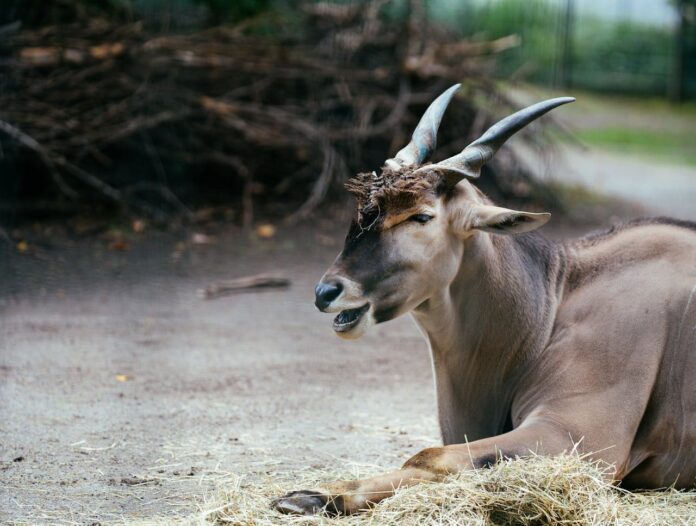We have talked about many largest animals before, but we haven’t discussed the largest antelopes yet. Antelopes are animals that are indigenous to various regions in Africa and Eurasia. The interesting thing about antelopes is that their horns grow continuously without annually shedding and growing like deer. There are 91 antelope species in total, but we are going to talk about the largest ones today. Let’s take a look at the list below and see what they are with us.
10Scimitar Oryx
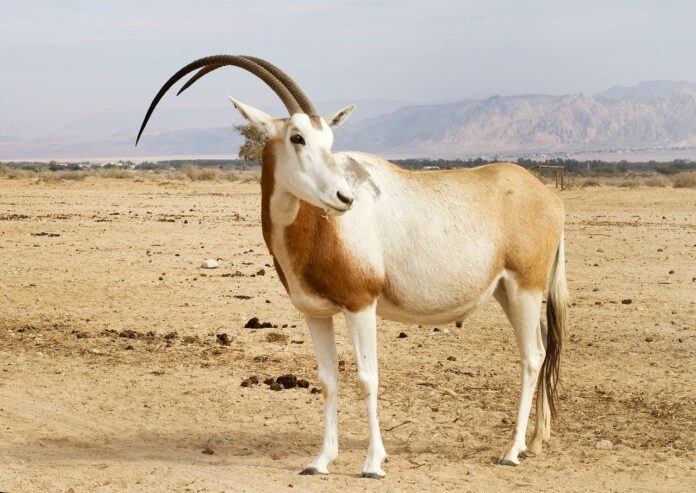
Height: 1 – 1.4 meter (3.3 – 4.6 feet)
Often known as the elegant and graceful antelope, scimitar oryx is one fascinating animal since ancient times. This antelope species is supremely adapted to desert life with an amazing ability to tolerate extreme heat, allowing them to thrive in the desert. They do this by tolerating their body temperature so that they don’t sweat; hence coping with the water shortage. This also means they are able to go for long periods without drinking water as well. A scimitar oryx has a white coat that helps to reflect the heat of the desert to keep it cool. Along with that, its black skin and the tip of the tongue protect it against sunburn as it walks. Speaking of walking, scimitar oryx also has enlarged hooves that enable it to walk on sand easily. Plus with dense eyelashes and strong eyelids, the windblown sand can never bother them anyway.
Many people believe that scimitar oryx could be behind the legend of the unicorn. A scimitar oryx has long, ridged, and sharp-tipped horns that curved backward and can grow for several feet long. Ancient Egyptians domesticated them and used to bind their horns together to make them appear like they had one horn. Then their horns would grow together, and that was probably how the unicorn myth was born. Even if it is one of the largest antelope, this species is currently extinct in the wild since 2000. Several factors such as drought, food loss, human disturbance, and overhunting harmed their population greatly. Although there is a project to reintroduce them back into the wild, there are still problems because they are migratory animals. Hopefully, there will be more of them in their natural habitats one day soon in the future.
9Bongo

Height: 1.1 – 1.3 meters (3.6 – 4.3 feet)
Large and colorful, bongo is a beautiful antelope species with a unique appearance that you can tell right away. A bongo antelope has large ears and spiral horns, and its body has vivid markings and stripes similar to zebra. The only difference is that their coloration is bright chestnut or dark brown, so recognizing one is easy and quick. Bongo is one of the largest antelope in the world, and this species is the largest forest antelope in the wild. Another special thing about them is that they are able to jump very high when they need to. However, they often prefer to go around or under obstacles instead of using their incredible skills. These antelopes are able to through dense forests swiftly with another special skill. They tilt their chin up, causing their horns to lie flat against their back; hence their bald back spots.
These heaviest, largest, and most colorful African forest antelopes live in dense forests, forest-savannas, and rainforests across the continent. Not different from scimitar oryx, this antelope also associates with some beliefs back in the old days. Native people believe that if they eat or touch a bongo, they will have spasms similar to epileptic seizures. Thanks to these superstitions, bongos have been living safely with respect from people in their native ranges. The natural predators of these antelopes are leopards, lions, and hyenas, while humans are their biggest threat now. Bongo has become a prize target for big-game trophy hunters in their natural range. Habitat destruction by human activities is their main threat because that also affects dense vegetation which is their food source. Their number in the wild is uncertain because they are secretive so coming across one and the count is very challenging.
8Gemsbok
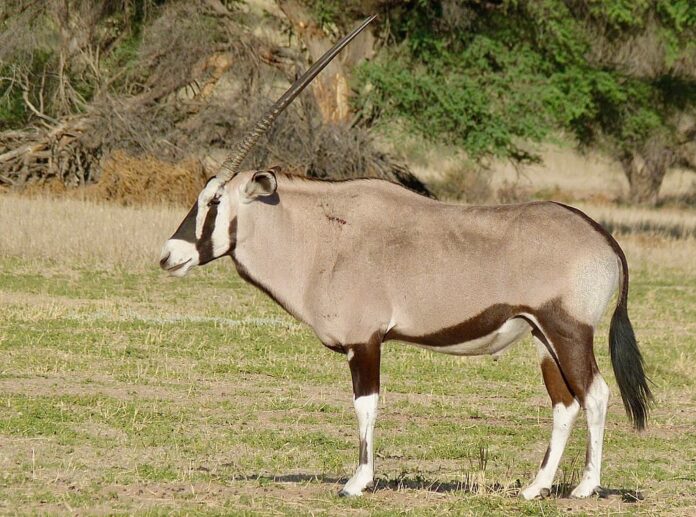
Height: 1.2 – 1.4 meters (3.9 – 4.7 feet)
Gemsbok or Kalahari is a handsome-looking antelope species that can stand as tall as 1.2 meters. This antelope is also one of the largest and most well-known oryx species among the 3. A gemsbok has a dark stripe that extends from its chin down to the bottom of its neck, over its shoulder joints. Gemsboks have a horse-like posture with muscular necks and shoulders, and they actually gallop when they run. One of their most noticeable features is definitely the horns, which can reach 1.2 meters in length. That’s right, their horns can be as long as their height. Those horns are not just for show because gemsboks use them as weapons against predators and in territorial combat. Thanks to the sharp pointed horns, a gemsbok can also kill a lion with those.
Along with their impressive appearance, gemsbok is also very strong with the ability to adapt to arid environments. They have a slow metabolism that allows them to survive up to a year without drinking water. This is also because they are able to get the moisture that they need from the food that they eat. A gemsbok’s main diet is desert melons that they dig up in times of drought. These desert dwellers also feed on tough dry grasses, supplemented with foliage. With everything combined together, they are able to live in deserts, brushlands, and scrublands in South Western Africa easily. In their ranges, these sociable animals spend time on open plains in a herd of 10 or more individuals. Their population is doing okay, but their threats are still humans who hunt them for their horns and meat.
7Waterbuck
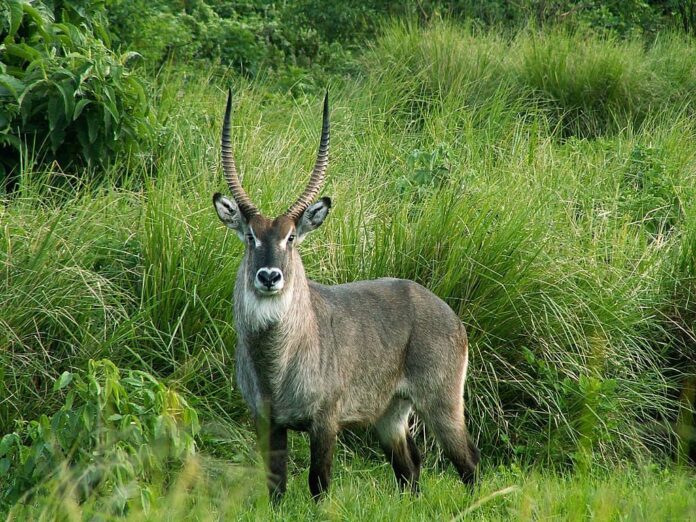
Height: 1.2 – 1.4 meters (3.9 – 4.7 feet)
Commonly known as the sabi sabi, waterbucks are very different from most of the others on the list today. You might get from their name, waterbucks are very dependent on water. Their habitats are areas close to water in gallery forests, riverine woodlands, and savanna grasslands. This also means they never live or stay too far from a permanent water source in their habitats. In fact, they have been known to evade predators by rushing into the water as well. Since their main predators are large cats that don’t like water, these antelopes survive to live another day many times. A waterbuck also has a trademark white ring around its hindquarters that serves as a “follow me” mark. If one of them spots a predator and runs, their members can easily follow.
If you look closely, you can see that sabi sabi has a lot of hair around its neck. This appears as if it belongs to colder climates, not somewhere hot in Africa. The hair is actually hollow, and it allows for extra buoyancy to help them keep their heads above water when swimming. These antelopes release a special oil over their body that repels water so keep it dry. The oil does not only repel water but also insects like ticks because it has a foul smell which is distasteful. Where they almost permanently live, damming and rerouting water for hydroelectric power are possible threats to them. Another threat is habitat destruction from agricultural development that destroys their grassland habitats. Plus with the uncontrolled hunting, many waterbuck species are declining in number every year.
6Nilgai

Height: 1 – 1.5 meters (3.3 – 4.9 feet)
At a glance, no one would believe or think that this hardcore animal here is actually an antelope species. Nilgai is not only one of the largest antelopes in the world but also the largest antelope in Asia. This species is native to the Indian subcontinent, and its appearance cannot be mistaken for any others. A nilgai stands tall on its sturdy slender legs, and it has a deep neck and sloping back. There is a white patch on its throat along with a short mane behind and along its back behind the shoulders. Its forelegs are longer, and all 4 legs often have white markings that resemble socks. Males have horns and thicker skin on their and necks to protect them in fights while females lack those.
Nilgais prefer areas with short bushes and scattered trees in grassy plains and scrub forests. These antelopes are also common in agricultural lands since they are able to adapt to a wide range of habitats. Not different from most antelope species, this one is also adaptive to arid regions. Simply put, they can live several days without water by getting moisture from their food. Looking bulky and all, nilgais will flee if alarmed or harassed by galloping away from the danger. Their main threats are deforestation, habitat degradation, and hunting. Farmers in several north Indian states consider them as agricultural pests because they raid and trample crop fields, causing damages. Even with threats, its population is actually abundant and widespread throughout its ranges.
5Hartebeest
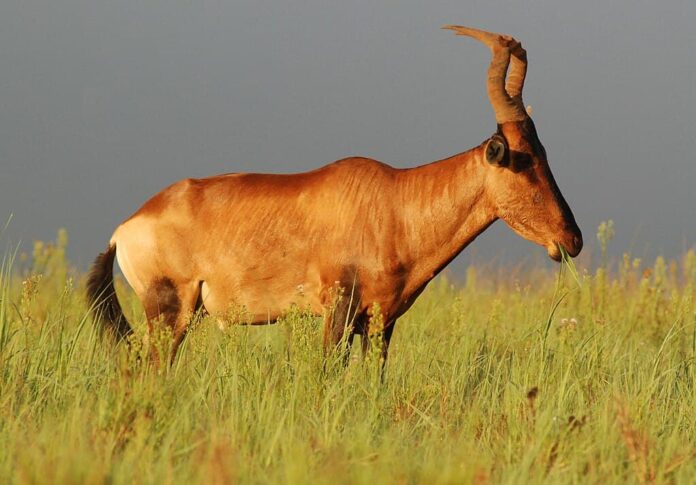
Height: 1. – 1.5 meters (3 – 5 feet)
Hartebeest is a large antelope with several distinctive characteristics that make them unique from the others. A hartebeest has an elongated forehead and snout that gives the slender look on the face. It has a steeply sloping back with long legs that make it one of the tallest and largest antelopes. Those legs make them amazing and fast runners, capable of reaching speeds of up to 70 km/h (43.5 mph). Because they live in grassland and open plains, this ability to run definitely saves their lives from predators like cheetahs. Other common predators are hyenas, hunting dogs, jackals, leopards, and lions.
Where they live, these gregarious animals form herds of up to 300 individuals or more if the grass is abundant. In each herd, there are 4 groups including territorial adult males, non-territorial adult males, young males, and females with their young. Sometimes females form groups of 5 to 12 and fight for dominance over the herd so sparring between them is common. But they are great in a team, with one individual usually staying on the lookout for danger while feeding. Hartebeests are widespread in Africa, but their population declines drastically due to competition for food, habitat destruction, and hunting.
4Sable Antelope
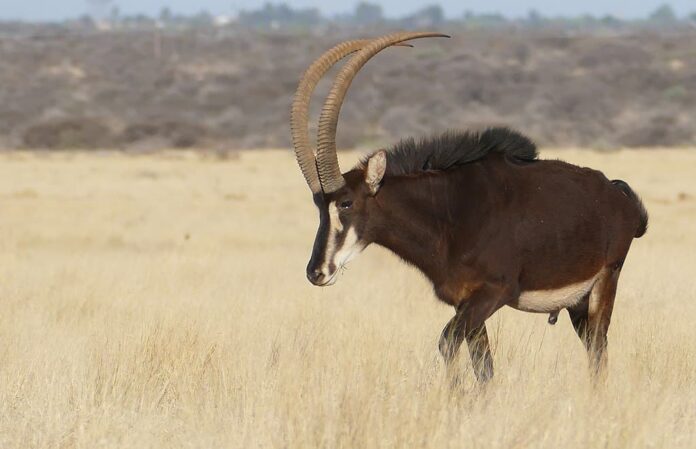
Height: 1.3 – 1.5 meters (4.2 – 4.9 feet)
Looking quite similar to the scimitar oryx, sable antelope is also one of the largest antelopes in the world. A sable antelope has astounding horns with a painted face and a noble look whose beauty is very admirable. Their horns can grow as long as 1.6 meters (5.2 feet) which is almost the same length as an elephant tusk. In fact, their horns grow over their entire lifetime which you can tell by the number of rings. There is a new ring each year, and this is also how we can determine their age. The horns grow straight and tall at first, and they slowly turn arc backward that bring them their magnificent beauty. When they want to show off, they will push their chests forward and raise their neck toward the sky. Then they will pull their shoulders back, presenting their amazing horns.
This antelope species is also one of Africa’s most iconic species due to its distinctive and majestic appearance. Sable antelopes have powerful stature and thick neck with erect manes along their back, showing immense power. The looks also come with the aggressiveness because the males will fight for females and territory. Guess what involves in the fight, their horns. Many sable antelopes clash horns in battles, and fatalities resulting from the fights are also common. In the wild, their predators are lions, leopards, hyenas, and of course, humans. Because of their appearance and value, sable antelopes are under threat due to habitat destruction and trophy hunting. There are only about 50,000 sable antelopes remaining across 11 countries, and their number keeps going down. If hunting is still going on, their population will no longer be here in the next few years.
3Greater Kudu
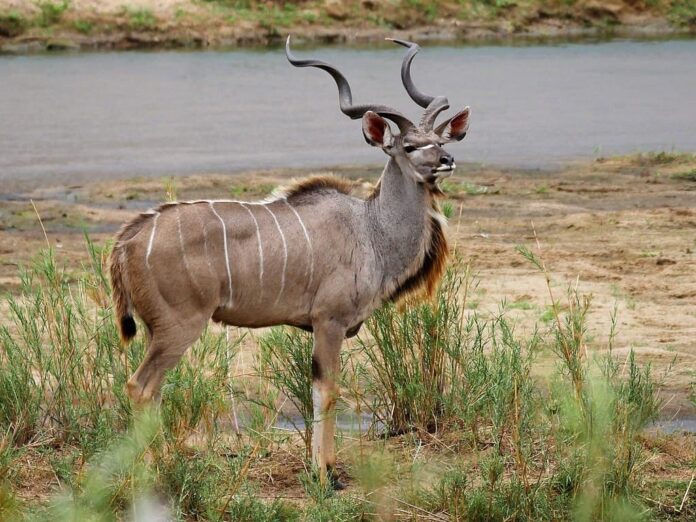
Height: 1.2 – 1.6 meters (3.9 – 5.2 feet)
As one of the largest antelopes in the world, great kudu is a very impressive species in Africa. It is most common in Southern Africa, but some species also occur in East Africa and the Horn of Africa. In those areas, their habitats are lightly wooded savannas and rocky bush country where they cover to avoid predators. Because their predators are dangerous animals like hyenas, leopards, lions, and wild dogs, these antelopes are highly alert. As you can see, they have super large ears that function as radar that they use to detect danger around them. Once they find a predator, they give a hoarse alarm bark to alert others before fleeing with their rocking-horse running motion. In spite of being large, greater kudus are actually light; hence their ability to leap over high fences and obstacles.
Appearance is one of the most fascinating things about the greater kudus. They have incredible horns with two and a half twists that can reach 120 centimeters in length if straightened. Some bulls may have three full twists that can grow as long as 187 centimeters which is insanely long. Male kudus are rarely physically aggressive, but they may spar during the courtship season by shoving one another using their horns. In such contests, their horns will interlock and both males may die if they are unable to free themselves. Those horns cannot protect them from hunters who shoot them for their hides, horns, and meat. Local people also use their horns in rituals, to make instruments, or to store honey. Greater kudus are considered Near Threatened with only around 118,000 remaining in the wild, according to the African Wildlife Foundation.
2Roan Antelope
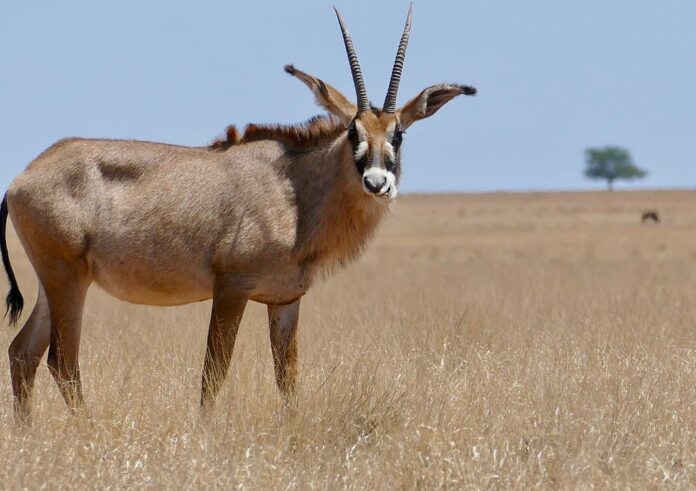
Height: 1.3 – 1.6 meters (4 – 5.2 feet)
Got its name from the reddish-brown color, roan antelope is one of the largest antelopes with an impressive horse-like build. A roan antelope stands tall with a powerful figure of the thick and muscular neck. This species has a short erect mane on its back, and its most special characteristic is the face markings. At the same time, they have long horns that are strongly curved backward, especially in males. Those horns are beneficial for them when it comes to confronting predators like lions and other big cats. Besides defending themselves, they also use their horns to fight each other over females and territories within their group. The appearance of roan antelopes is very similar to sable antelopes, and they can be confused where their ranges overlap. You can easily recognize roan antelopes by their beautiful and majestic black and white faces.
Roan antelopes are found in Central, Southern, and West Africa where they live in subtropical and tropical grasslands. They also live in shrublands, savannas, and woodland if there are enough food resources for them to feed on. As gregarious animals, they form harem groups of 5 to 15 females with a dominant male. Females also often fight for dominance, so harming groups of males with a dominant female is also common. Roan antelopes are shy but very brave when threatened so they are not afraid to confront predators if need be. Unfortunately, their main threats are not the predators that they can fight off. Habitat loss and poaching by humans are the main causes of their population decline in the wild. This is why they mainly survive only in or near protected areas today.
1Giant Eland

Height: 1.8 – 2.2 meters ( feet)
Great elands are the largest antelopes in the world, and their striking appearance is second to none. A great eland has a smooth chestnut to reddish-brown coat with 8 to 12 well-defined vertical white stripes. Male great elands are usually darker than the females, and their coat darkens with age. Both sexes have slender legs with black and white markings just above the hooves. They also have tightly spiral V-shaped horns, and males have longer, more divergent, and thicker horns at the ends. These magnificent antelopes live in broad-leafed savannas, forests, fringes of deserts, and glands of Central and Western Africa. Also, they inhabit places near hilly or rocky landscapes where there are water sources nearby.
Where they live, great elands live in separate groups of males and females with juveniles. Adult great elands are solitary so they mainly remain alone and often spend time with females for an hour to a week. In groups, a male will give deep-throated barks when he senses danger until the whole herd is aware of the danger. Even though they are the largest antelopes, great elands are great jumpers with an impressive height of up to 1.5 meters. Although they are easily taken down, they have many predators such as hyenas, leopards, and lions. However, their main threats are habitat destruction, overhunting for their hides and meat, and trophy hunting, making them a Vulnerable species.
Related Post: Largest Wild Bovines

